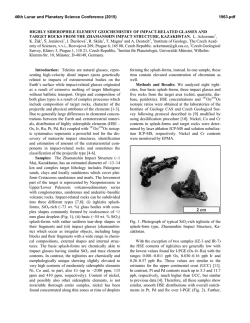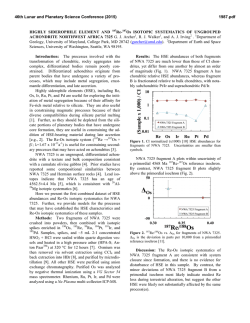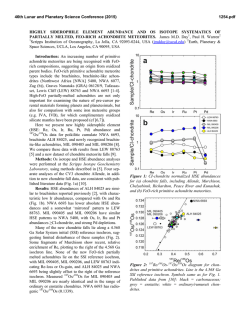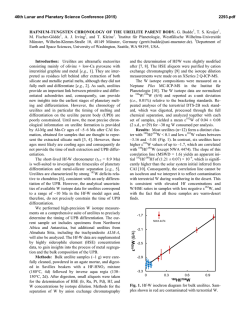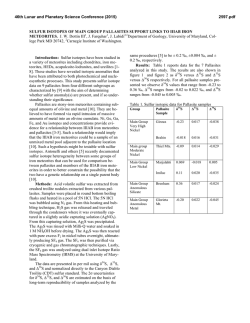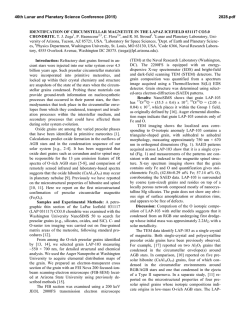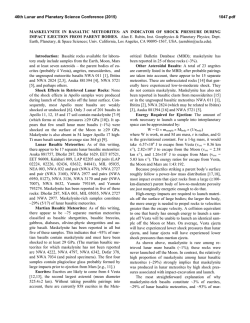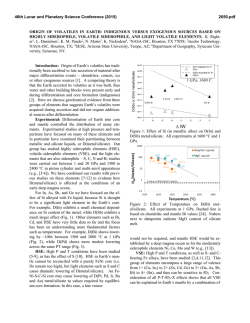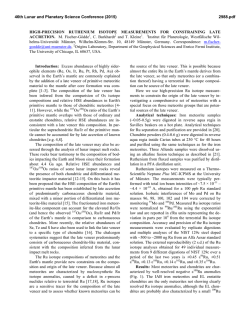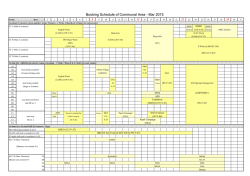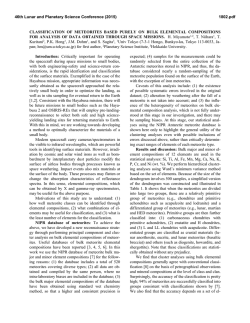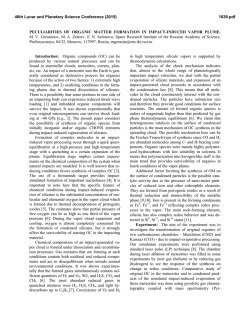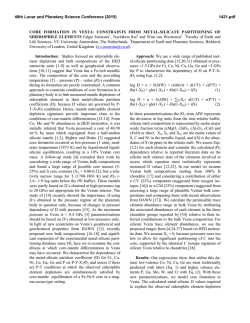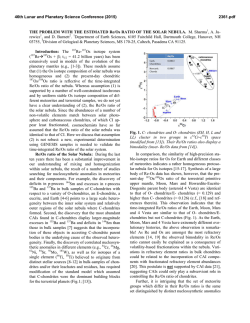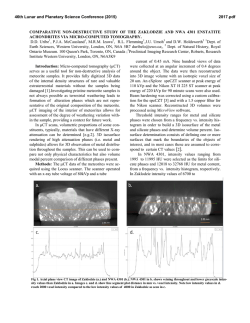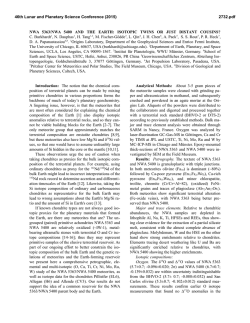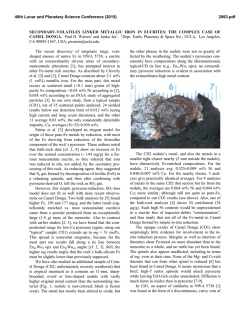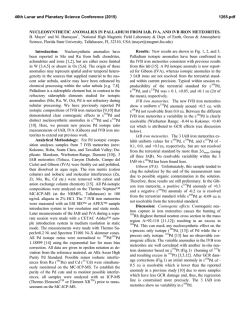
187
46th Lunar and Planetary Science Conference (2015) 1595.pdf HIGHLY SIDEROPHILE ELEMENT ABUNDANCES AND 187RE-187OS SYSTEMATICS OF ACAPULCOITE-LODRANITE METEORITES. J.K. Dhaliwal1, J.M.D. Day1, C.A. Corder1, K.T. Tait1,2, K. Marti1 1Scripps Institution of Oceanography, UCSD, La Jolla, CA 92093: [email protected]. 2Department of Natural History, Royal Ontario Museum, Toronto, Canada. ! Introduction: Acapulcoite and lodranite meteorites are early-formed (182Hf-182W age = ~4562.8 ± 1.1 Ma) primitive achondrites [1] that have similar oxygen isotope systematics, indicating derivation from one or more parent bodies [2-3]. Acapulcoites and lodranites show variable degrees of partial melting (<1 to 20% [3]), occasional relict chondrules [4], and are relatively coarse-grained, containing variable abundances of metal and troilite [3-6]. Acapulcoites have been suggested to represent high-grade metamorphic rocks in which partial melting in the Fe-Ni-S system occurred [5,7], whereas lodranites are considered residues after partial melting, and removal of Fe,Ni-FeS and basaltic partial melts [3,8]. Along with the ureilite [9] and brachinite [10] meteorites, these primitive achondrite meteorites indicate FeNi-S melt-loss in response to variable partial melting (Fig. 1). Acapulcoites and lodranites are therefore valuable for studying differentiation and metal-sulfide melt segregation during the earliest stages of planetary differentiation. Methods: Samples were prepared and analyzed at the Scripps Isotope Geochemistry Laboratory (SIGL) for 187Os/188Os ratios and HSE abundances, using methods described previously (e.g., [10]). Results: Absolute and relative abundances of the HSE in acapulcoites (ALHA 81187, MET 01195, NWA 2871, Acapulco) are similar to chondrites (e.g., Kyle, Banten) (Fig. 2). Lodranites and acapulcoite-lodranites exhibit much greater variation in absolute abundances of the HSE, and some samples (cf., NWA 4875) show non-chondritic relative HSE abundances. ! ! ! Figure 2: Chondrite-normalized HSE abundances for acapulcoite-lodranite meteorites. CI-chondrite normalization from [11]. ! Figure 1: Abundances of metal and troilite in brachinites, ureilites, acapulcoites and lodranites; assuming similar reduced pre-cursor compositions, lower metal abundances are associated with higher degrees of melting and HSE contents lower than in chondrites [Data from 3-5]. ! Here we apply highly siderophile element (HSE: Os, Ir, Ru, Pt, Pd, Re) abundances and Os isotopic ratios to examine differentiation processes in acapulcoite and lodranite meteorites, including Antarctic and hot desert finds (acapulcoites: MET 01195, ALHA 81187, NWA 2871, Acapulco; lodranites: GRA 95209, NWA 4833, NWA 4875, and acapulcoite-lodranite EET 84302). We also present new data for chondrite falls: Banten (CM2), and Fayetteville (H4), and the L6 find, Kyle. ! ! Figure 3: 187Re/188Os - 187Os/188Os diagram for acapulcoite-lodranites showing the 4.568 Ga IIIAB iron meteorite reference isochron [12]. ! Another notable feature of the dataset is that Pd/Pt in most of the meteorites are <1, but in the fragment of Acapulco that we measured, Pd/Pt is >1. 187Os/188Os for all samples are within the range of chondrites (0.12 46th Lunar and Planetary Science Conference (2015) - 0.13 [13-14]), but there is some scatter around the 4.568 Ga reference isochron (Fig. 3), possibly consistent with recent disturbance of the 187Re-187Os system. Discussion: The broadly chondritic HSE abundances of acapulcoites are consistent with the concept that these meteorites are the result of high-grade metamorphism and anatexis, resulting in limited removal of FeNi-rich and S-rich melts and similar bulk compositions to ‘chondritic’ pre-cursor materials. In contrast, the variable HSE abundances of lodranites indicate both higher degrees of Fe-Ni-S-rich melt removal (e.g., NWA 4875), as well as some meteorites that contain a metal-rich cumulate component (e.g., EET 84302, GRA 95209). These same meteorites have been shown to have a high FeNi metal content [15], consistent with accumulated metal phases within them. In order to further quantify metal-sulphide removal or addition in acapulcoites and lodranites, we have employed melting models of chondritic pre-cursor compositions with the goal of examining Fe-Ni-S melting in the system [e.g. 16]. During metal-silicate differentiation Pd/Os and Pt/Os (Fig. 4) track melt-removal of less compatible Pd and Pt to more compatible Os. In this system, greater sulfur content increases the (solid) compatibility of the HSE, resulting in lower HSE abundances in the residual liquid; a collateral effect is changes in HSE inter-element fractionation trends between variable-S melts. The differences in Pt/Os ratios among acapulcoites and lodranites (Fig. 4) indicate the influence of sulfur content in the melt. The majority of samples are closely modeled by 25% sulfur in the extracted melt. This may represent a simple one-stage model of sulfide-rich melt extraction (as observe for ureilites and brachinitelike achondrites [9-10]) and possibly complementary to iron meteorite compositions [17-19]. NWA 4833 and NWA 4875, however, plot close to the 0% sulfur curve, indicating the extraction of sulfide-poor metal. Fractionation in the presence of low sulfur content typically requires more extensive liquidcrystal fractionation [17] and so this may reflect a more complex mechanism, such as retention of multiple phases in the residue (i.e. metal and sulfide) or two-stage melting, as has been suggested for brachinite achondrites [10]. The high Pd/Os ratio observed in Acapulco is not represented by the Fe-Ni-S system and may represent a primary feature of the sample. Alternatively, variable ages (e.g. distinct U-Pb systematics in plagioclase and troilite [20]) suggest a secondary event that may have resulted in Pd addition. The HSE abundances among the primitive achondrites range from 0.1 to 10 times CI-chondrite, indicat- 1595.pdf ing extraction of liquid metal. The brachinites, characterized by the lowest overall metal content and higher degrees of partial melting, exhibit strong inter-element fractionation [10]. This contrasts with ureilites and acapulcoites that are metal-rich and show largely chondritic HSE relative abundances, possibly indicative of single-stage removal of metal melt [e.g. 9]. The singular HSE patterns observed in high-metal lodranites may complement the low-metal brachinites; together, these may indicate metal-silicate partitioning behavior at the beginning (i.e. core formation) and end (i.e. mantle segregation) of planetary differentiation. Figure 4: CI-normalized Pt/Os versus Pd/Os ratios for acapulcoites and lodranites. Modeled curves show residue compositions for a system with no sulfur and 25 molar % S (based on [16]). Symbols same as Fig. 3. ! References: [1] Touboul M. et al. (2009) EPSL, 284, 168-78. [2] Clayton R.N. and Mayeda T.K. (1996) GCA, 60, 1999-2017. [3] McCoy T.J. et al. (1997) GCA, 61, 639-650. [4] McCoy T.J. et al. (1996) GCA, 60, 2681-2708. [5] Mittlefehld D.W. et al. (1996) GCA, 60, 867-882. [6] Rubin A.E. (2007) GCA, 71 2383-2401. [7] Palme H. et al. (1981) GCA, 45 727-752. [8] Bild R. W. and Wasson J.T. (1976) Mineral Mag., 40, 721-735. [9] Rankenburg, K. et al. (2008) GCA, 72, 4642-4659. [10] Day J.M.D. et al. (2012) GCA, 81, 94-128. [11] Horan M. et al. (2003) Chem Geo, 196, 27-42. [12] Smoliar M.I. et al. (1996) Science, 271 1099-1102. [13] Walker R.J. et al. (2002) GCA, 23, 4187-4201. [14] Fischer-Godde M. et al. (2010), GCA, 74, 356-379. [15] Corder C.A. et al. (2014) LPSC XLV, Abstract #2752 [16] Chabot N. and Jones J.H. (2003) Meteoritics & Planet. Sci., 38, 14251436. [17] McCoy T.J. et al. (2011) GCA, 75, 6821-6843. [18] Walker R.J. et al. (2008) GCA, 72 2198-2216. [19] Cook D.L. et al. (2004) GCA, 68, 1413-1431. [20] Gopel, C. et al. (1992) Meteoritics, 27, 226.
© Copyright 2026
